Body temperature is the biggest indicator of a dog’s overall health. A dog’s body temperature can provide early clues about inflammation, infection, stress or heat exhaustion. Changes in a dog’s body temperature, such as fever in dogs or hyperthermia can serve as a warning sign of a disease.
Pet parents should always consider checking their dog’s temperature if their pupper misses 2 meals in a row, refuses to play, appears lethargic or goes into hiding. An early detection of fever in dogs can help your pet get the veterinary care they require. It can prevent unwarranted complications and suffering.
What is the Normal Temperature Range for Dogs?

The normal body temperature of a healthy dog is between 101°F and 102.5°F (approximately 38.3°C to 39.2°C).
A dog’s body temperature above 103°F is considered high or a fever. If the temperature is above 105°F it is a high fever in dogs and critical – it demands immediate medical attention.
If your dog has a very high fever, begin pouring cool water on their head and abdomen, and switch the fan and AC on. Simultaneously, keep trying the veterinarian.
Unlike us, dogs always have a slightly higher normal body temperature. So whenever you touch your dog, they should feel warmer than your skin. That is normal.
To understand if your dog has a fever, you should use a proper thermometer.
How to Check if Your Dog has a Fever?
Do not rely on an infrared thermometer to check your pet’s temperature. Their fur coat always interferes with accurate reading.
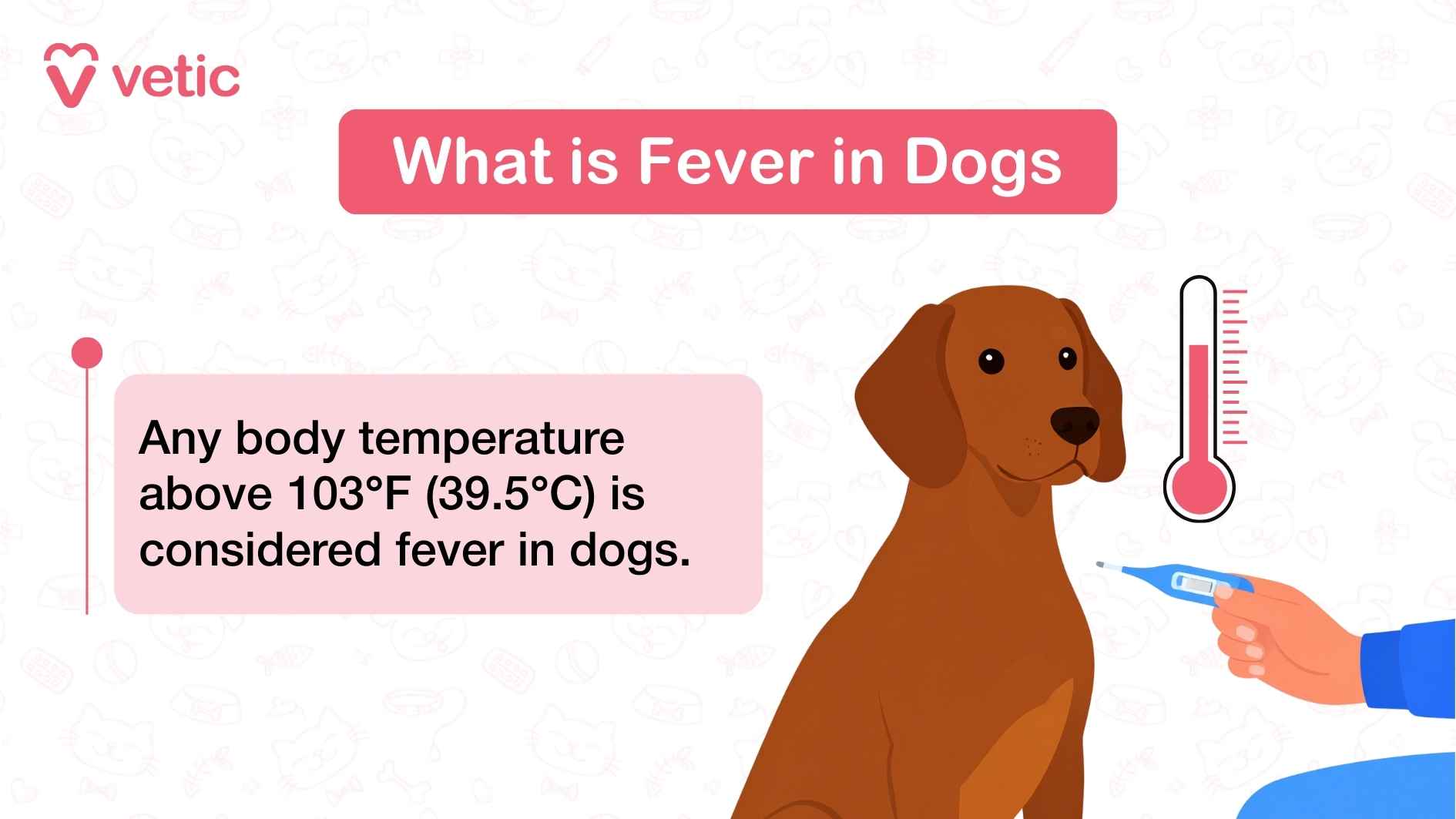
Use a digital thermometer, it’s better if you can get a veterinary rectal thermometer since they have flexible tips which ensure your pet doesn’t get hurt during the process.
- Lay your pet on their side or belly, and ask someone to help if you can’t do it alone. Take the digital thermometer and apply a little water-based lubricant on the tip of it.
- Lift your pet’s tail and insert the tip of the thermometer around 2-3 cm into the rectum. Wait for the thermometer to beep.
- Take the thermometer out – and note the reading with date and time.
- Remember to clean the thermometer with a disinfectant after each use.
Any reading above 103°F indicates a fever in dogs. You should call your veterinarian if the temperature remains the same or increases, 30 minutes after a cool sponge bath.
Why Is It Not Advisable for Pet Parents to Estimate Their Dog’s Temperature Using Their Hands?
You may have seen a lot of pet parents trying to estimate their dog’s temperature by feeling their ears, nose or belly. However, we do not recommend it since a dog’s natural body temperature is at least 3-degrees higher than our normal body temperature. So they always appear warmer.
The only way to measure your dog’s fever accurately is by using a digital thermometer or rectal thermometer. Although it may seem uncomfortable to us, it is the recommended method for checking canine body temperatures.
What Are the Signs of a Fever in Dogs?
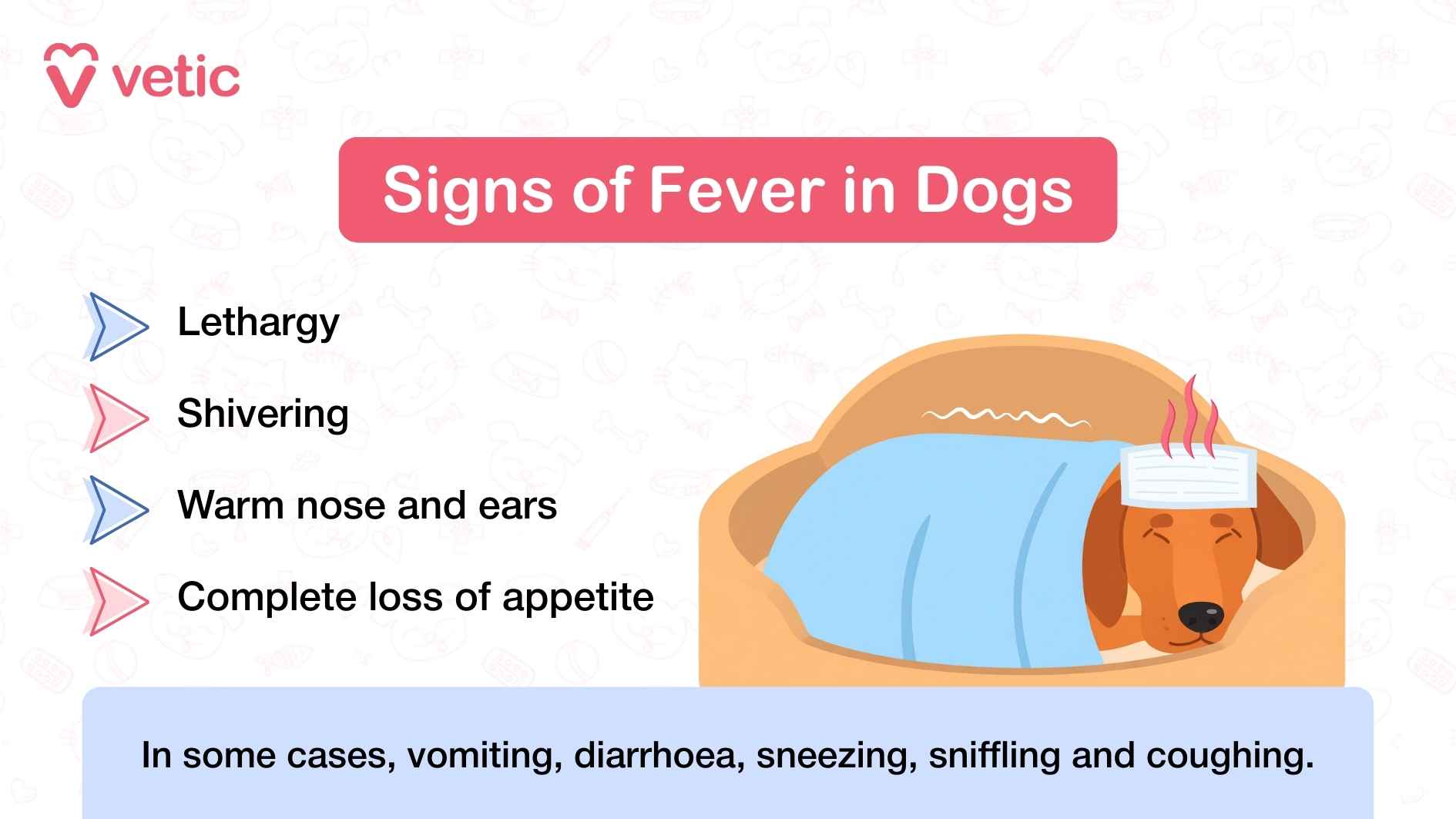
Not all dogs with high body temperature show the same signs. However, here are a few common signs of fever in dogs –
- Lethargy
- Shivering
- Warm nose and ears
- Complete loss of appetite
In some cases, the puppy or dog may also have vomiting, diarrhoea, sneezing, sniffling and coughing.
Not every dog will display these signs. If your dog is showing any sign of discomfort, you should take their temperature or take them to the nearest veterinarian.
What Does a Temperature Higher Than 103°F Signify?
A dog’s temperature above 103°F suggests an internal issue – can be the beginning of an infection, inflammation or even heat stress.
The most common cause of a mild rise of temperature above 103°F is recent vaccination. A puppy or adult dog can spike a fever within 24-48 hours of any vaccination.
It may not be an emergency, but it is indeed a sign that the immune system is fighting something. So, inform your veterinarian without delay. Do note if your dog is eating, drinking and playing normally. If not, you should act immediately!
What Can You Do When Their Dog Has a Fever: Temperature Between 103°F and 105°F?
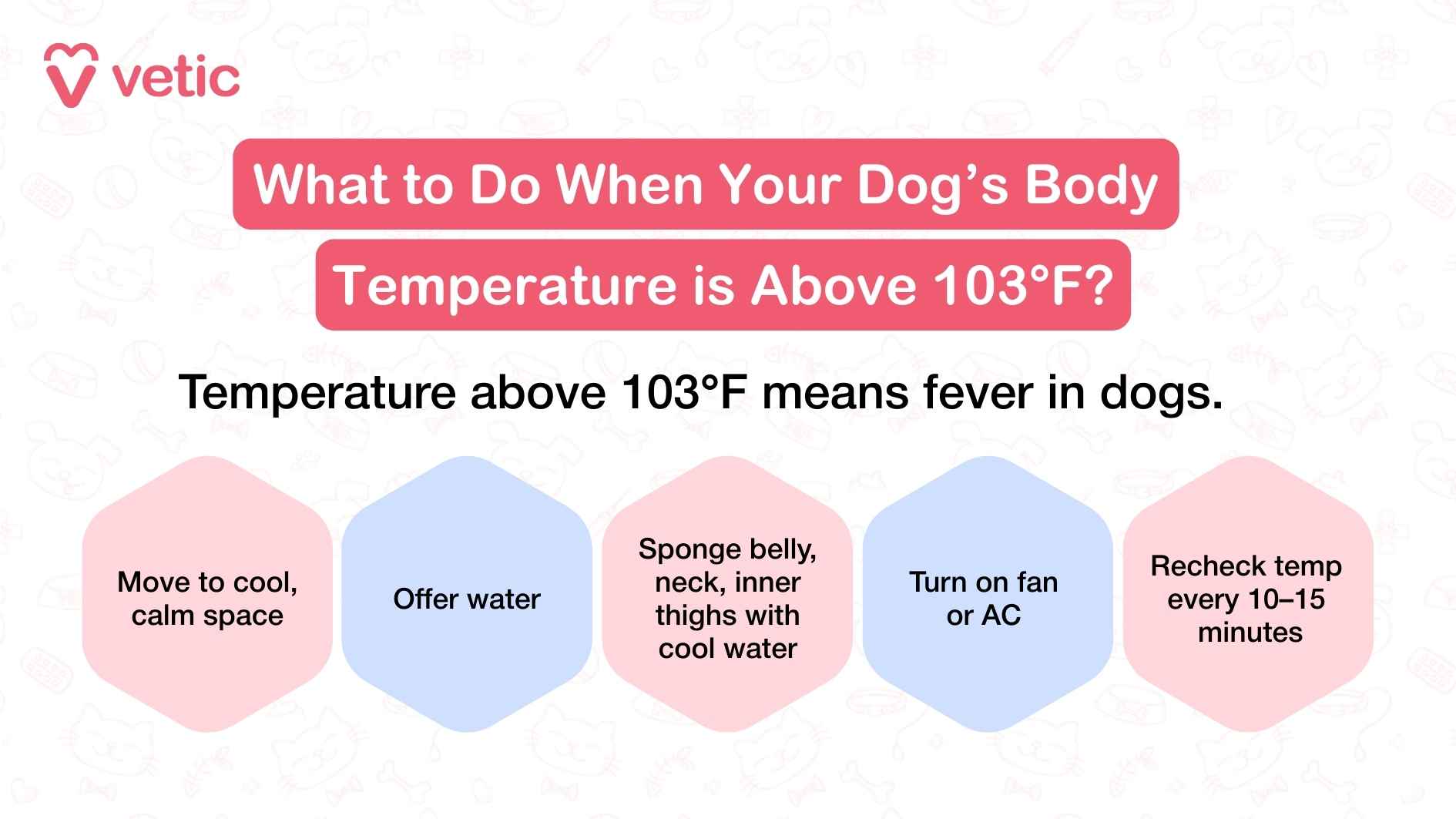
If your dog has a fever but their body temperature remains between 103°F and 105°F, you can do the following while preparing for your vet visit –
- Move your dog to a cooler area
- The room should be quiet and comfortable
- Give them access to fresh drinking water
- Apply a damp and cool cloth to their belly, inner thighs and neck
- Use a fan or the AC to circulate the air
Avoid using ice baths or ice packs directly on them.
Check their temperature every 10 to 15 mins.
What Does a Temperature Higher Than 105°F in Dogs Signify?
Very high body temperature in dogs is always critical and it can cause irreparable damage to their internal organs. Prolonged fever in dogs above 105°F can even cause the central nervous system to shut down.
Fevers above 105°F in dogs almost always result in seizures, collapse followed by unconsciousness.
These stages progress quickly and even a few minutes of delay can worsen the prognosis.
What Should You Do When Your Dog Has a Temperature Higher Than 105°F?
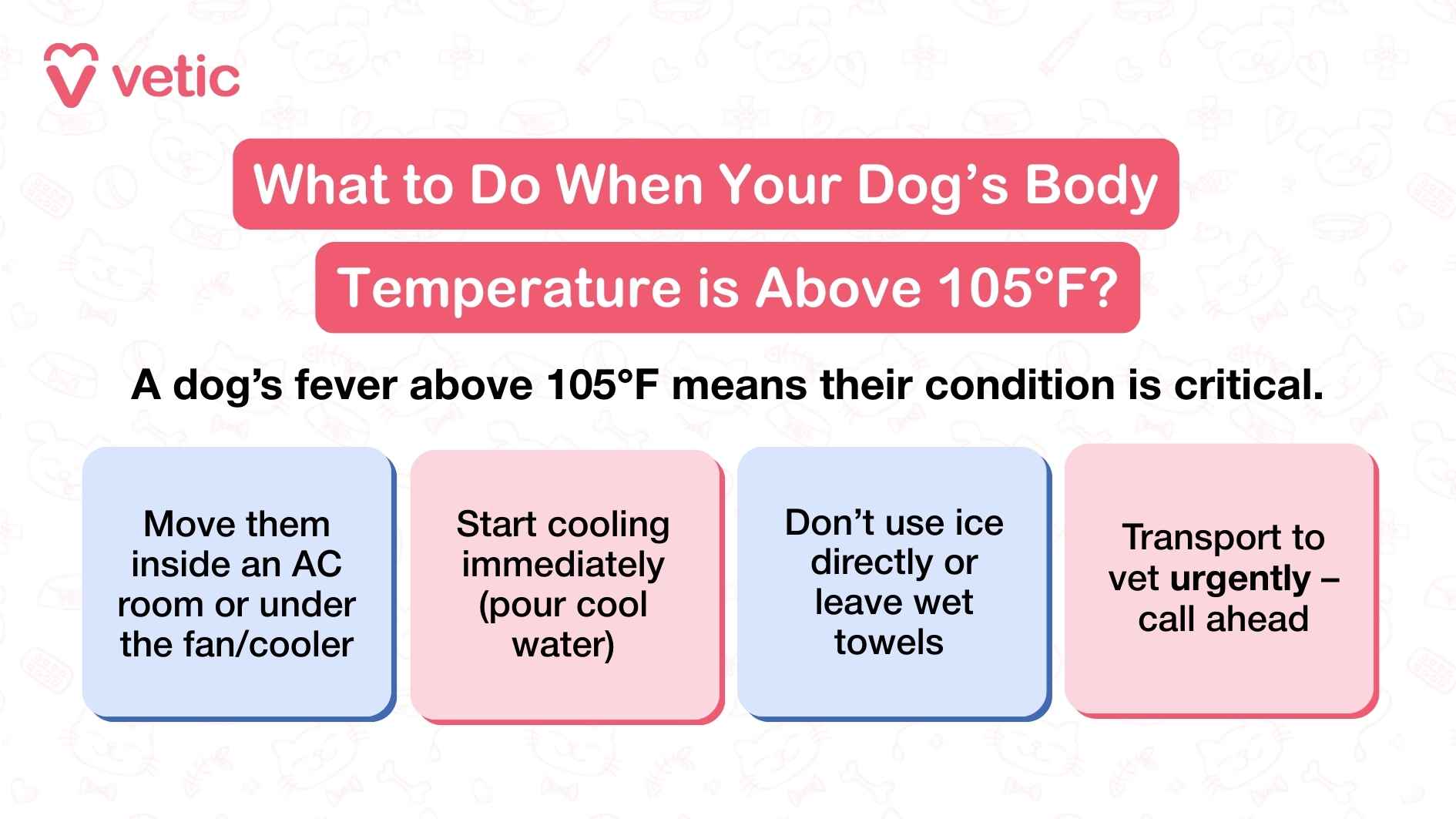
If your dog’s temperature reaches 105°F, move them to a cool place and begin cooling them by pouring cool water (not cold water). Sponge them with pieces of damp cloth on their belly, armpit, neck and paws. Switch the AC, cooler and fan on.
Do not use ice water or cover them with damp towels. Ice will constrict the blood vessels and prevent the release of heat, and the damp cloth will trap the heat.
Arrange for transport while you are trying to cool them and move your dog to a nearby veterinary clinic immediately. Let the team know in advance that you are coming in with a pet who has a temperature above 105°F. That will help them prepare for immediate care.
What Can Cause Fever or High Temperature in Dogs?
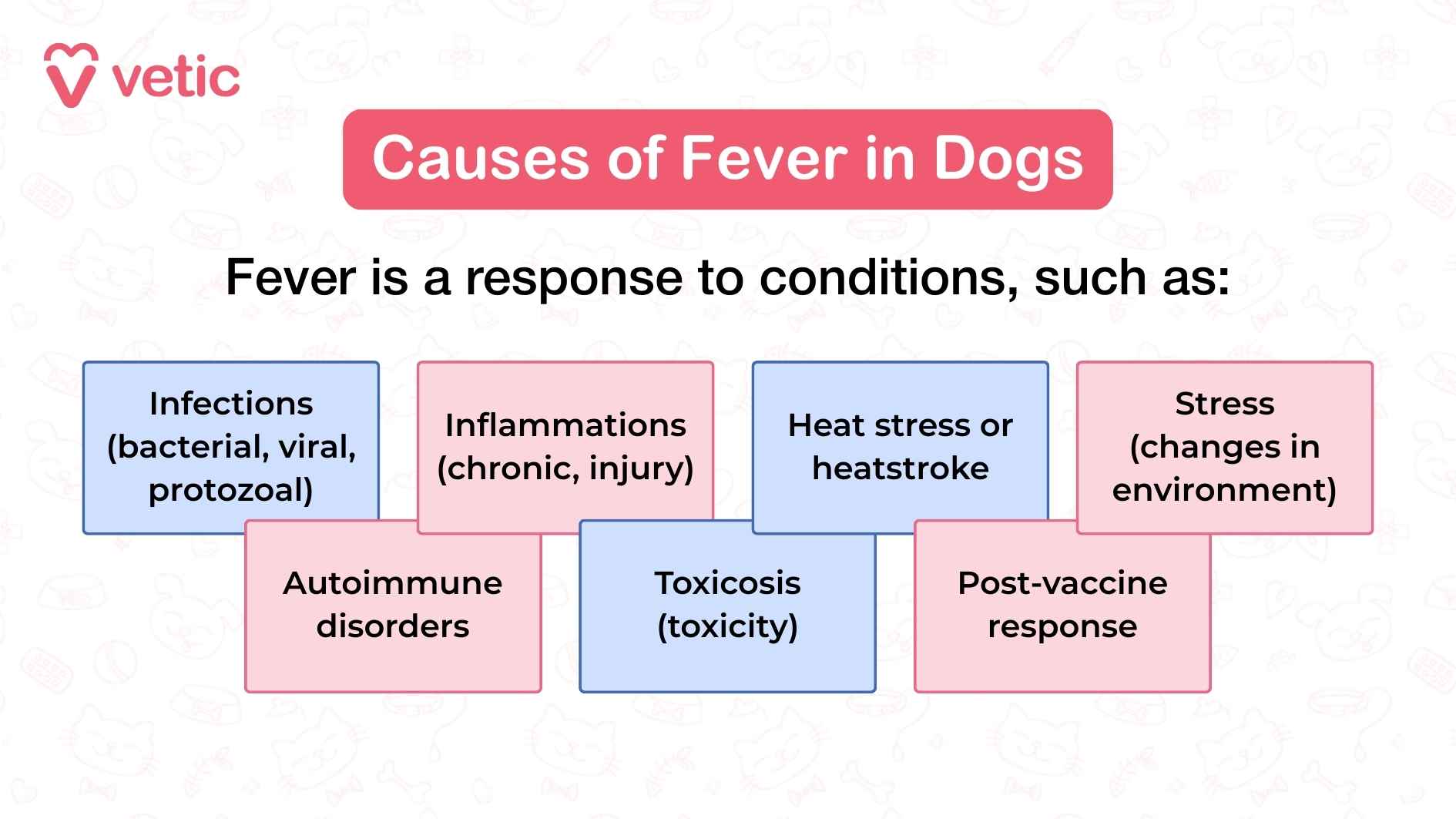
Fever in dogs can arise from many different causes. The most common include:
- Bacterial infections (urinary tract infections, infected wounds, dental disease)
- Viral illnesses (parvovirus, distemper)
- Tick-borne diseases (ehrlichiosis, babesiosis)
- Heatstroke from prolonged exposure to high temperatures
- Reactions to certain medications or vaccinations
- Autoimmune diseases or immune-mediated conditions
- Exposure to toxin
- Unexplained causes (fever of unknown origin)
A proper veterinary examination, often including blood tests, urine culture, stool culture and diagnostic imaging, is required to determine the exact cause.
Can You Prevent Fever in Dogs?
Not all types of fever in dogs are preventable. Nonetheless, you can prevent the ones caused by distemper, parvovirus, parainfluenza, tick fever and worm toxicosis by providing them with timely basic preventive care.
You can also avoid heat exhaustion and heatstroke by walking your dog during the early mornings and late evenings. Do not keep them in parked cars or closed rooms even for 5 minutes during the summers.
If your dog has wounds, injuries or abscesses, maintain the proper hygiene. Wash the wound with antiseptic and other medicines as directed by your veterinarian daily to prevent infection.
Take your dog for regular health checkups and monitoring. Stay on top of your dog’s behaviour and diet so you can note even the smallest issues and avoid major health problems.
Fever in Dogs: What You Should Never Do
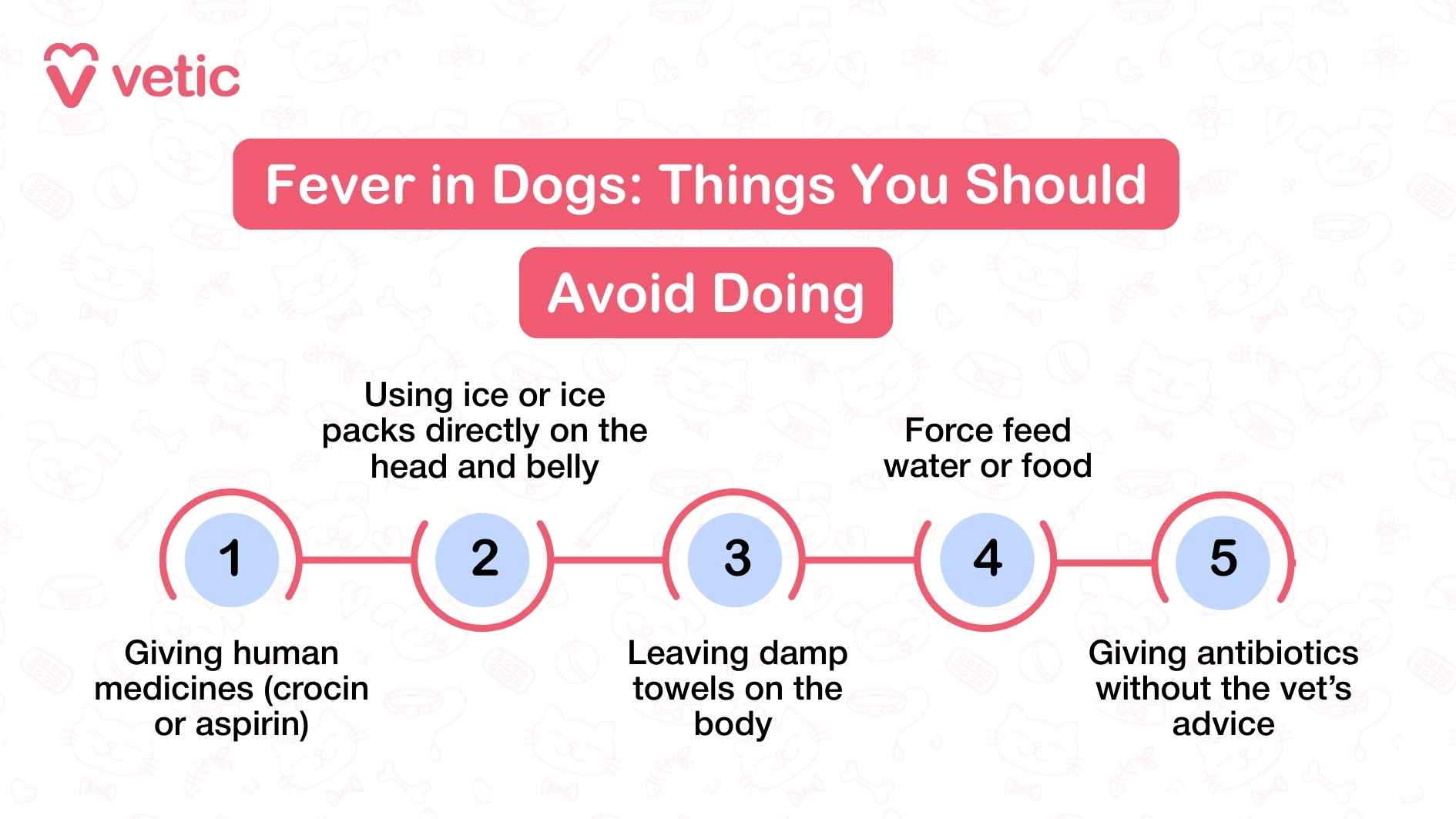
Some well-meaning home remedies can actually harm your dog. Here is what pet parents should never do when their dog has a fever:
- Do not apply ice directly to your dog’s skin. This can cause vasoconstriction and prevent the body from cooling naturally.
- Do not give human medications like paracetamol, Crocin, or aspirin. These can be toxic to dogs and may lead to liver damage, ulcers, or fatal reactions.
- Do not wrap your dog in wet towels for extended periods. Wet towels can trap body heat and make the fever worse if not used properly.
- Do not force-feed your dog. Loss of appetite is normal during illness, and force-feeding may cause vomiting or discomfort.
- Do not give them antibiotics without consulting the vet. Fevers can escalate rapidly, and improper treatment can lead to irreversible harm.
Always consult your veterinarian before attempting any treatment at home.
A fever in dogs is not something any pet parent should take lightly. It is just as serious as any infant or child running a high temperature. It is not safe to wait for 24 hours without any medical help and hope it resolves itself.
A fever can be a sign of tick fever, hepatitis, influenza, parainfluenza, toxicity, distemper or parvo. Waiting only makes these diseases worse. Seek veterinary care as soon as you realise your dog has a high body temperature.
